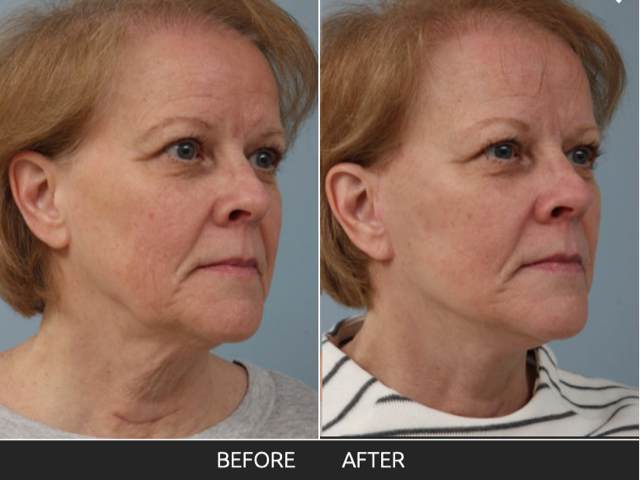“Facelift” is one of the more confusing terms in the cosmetic surgery industry.
The formal name for a facelift surgery is “rhytidectomy,” which translates to surgical removal (-ectomy) of undesirable wrinkles (rhytid(s)-).
This is not an entirely accurate description because we do not surgically excise each of the wrinkles — this would leave a very scarred-looking appearance.
Looking at popular online cosmetic resources, forums, and blogs, countless patients often inquire “what kind of facelift do I need?”
At The Williams Center, instead of thinking about what kind of facelift patients need, our team of experienced plastic surgeons urges individuals to think about what specifically bothers them about their personal appearance.
Do they have forehead lines they wish to remove, or a “turkey neck?”
A competent and experienced facial plastic surgeon will be able to describe what the surgery entails and what is necessary to achieve your desired results.

Patient had a weekend/mini facelift done, which improves the jaw line
What a Facial Plastic Surgeon Thinks When They Hear “Facelift”
When Dr. Edwin Williams thinks about a facelift, he thinks of resuspending the soft tissues of a patient’s neck, lower face and jawline, and some of their midface.
This perspective is largely shaped by the deep plane facelift technique, a procedure that allows Dr. Williams to achieve more lift on the midface.
The more commonly performed, less technically involved facelift techniques will have less effect on mobilizing these soft tissues, especially in the midface.
The deep-plane facelift is Dr. Williams’s “go-to” technique because it has the best, long-lasting results.
At The Williams Center, we refer to the standard facelift as a lower face/neck lift.
In short, a standard “facelift” could correctly be renamed a “lower face, neck, and midface lift”.
This discourse on what a facelift is illustrates why it is important for plastic surgery patients to focus on what about their face concerns them.
During their consultation, patients have a chance to vocalize these specific problem areas to the plastic surgeon.
If you are meeting with an experienced, board-certified facial plastic surgeon, you should be able to mutually develop a surgical plan, in addition to trusting their options and recommendations.
During this consultation, there is a discussion of what needs to be surgically addressed, instead of looking for a specific procedure.
How a Facelift Affects the Forehead
A facelift does not address the forehead.
It is a very common occurrence for a patient seeking a “facelift” consultation to answer the question of “what bothers you?” by using their fingers to lift their eyebrows in a demonstration of what they would like to surgically achieve.
Lifting the forehead is an entirely separate procedure from a facelift.
It certainly can be performed concurrently during a facelift, but it is a separate surgery that utilizes separate incisions, dissections and techniques.
How a Facelift Affects the Jowls
The “jowls” are the sagging, descended skin near your chin at the front of your jawline.
This is a common concern among patients that feel that they appear aged.
This is correctable with a conventional, “mini-facelift” or “weekend lift.” The important distinction between this and a deep plane facelift is that these patients do not need or desire a significant change in their neck.
The amount and extent of surgical dissection can be limited for these patients. As a result, they will oftentimes experience less bruising and an easier postoperative recovery.
How a Facelift Affects the Neck
The neck is typically one of the most motivating factors for a patient seeking surgery and is best addressed by our deep plane facelift technique.
There are alternatives and indications for separate procedures called “neck lifts” or “direct neck lifts” but when a patient is concerned with signs of aging in their neck, they will almost always be best served by having a facelift.
Depending on the amount of soft tissue present in the neck, we often will perform liposuction of this region during the procedure utilizing a small, hidden incision underneath the chin.
How a Facelift Affects the Midface
In approaching the midface, there are separate procedures called “midface lifts”.
These are not necessarily less invasive than a traditional facelift.
One of the reasons why we utilize the deep plane facelift is that we can improve the soft tissues in the midface while also addressing the lower face and neck.
There are reasons to performing a midface lift, oftentimes in conjunction with a browlift as they can utilize similar incisions. However, most of our patients can receive the benefit of lifting the midface while simultaneously undergoing a facelift — or more accurately described, a “lower face, neck and midface lift.”
Although this can be confusing for our patients, the key point to remember is that once we are able to discuss your aesthetic concerns and desired surgical goals, we can describe the extent of surgery as well as the incisions necessary to achieve your desired result.
The type of technique that a plastic surgeon utilizes for their “facelift” will greatly impact not only the regions of the face that are able to be addressed but also the longevity and effectiveness of the lift.
Utilizing the deep plane facelift takes more time, training, comfort, and experience. However, we know that this best serves our patients’ surgical goals, and we are committed to helping them get their desired results.
Contact Us for a Facelift Consultation
The surgical community does not have a clear and accurate nomenclature for the facelift procedure.
If you can verbalize your concerns and surgical goals with an experienced, board-certified facial plastic surgeon, we will be able to formulate a plan that will help you achieve your results.
At the end of your consultation, feel free to ask us how we would name it.
Give us a call at (518)-786-7000 or schedule a consultation today and let’s start your journey to a more perfect you.
